February 19th-25th 2012
One of the joys of living in this country is the flow of the seasons. 'Flow' is the operative word here as some years winter never seems to end and spring never begins, the former's sub-zero night-time temperatures and biting north-easterly winds giving way to sub-tropical midsummer heat within the space of a few days in late May, bypassing the spring altogether! Thus, to those of us addicted to the seasonal flow March and April are two of the most important months of the year as when they are blessed with days of gentle warmth and south or south-westerly breezes butterflies, wild flowers, bees, moths, migrant birds and other wildlife all appear in due order and give a smooth but steadily increasing momentum to the spring.
The snow and frost of mid-February now behind us the temperature rose steadily this week to a balmy 17`C on 23rd, almost twice the average at this time of year. What a joy it is on such a day to relax on a seawall somewhere, tucked down out of the breeze, coffee and sandwiches to hand, and soak up those first blissfully warm rays of the spring. It will be too ruddy hot soon enough!
Wildlife duly responded : a Peacock in the garden on 23rd was followed by a Brimstone at The Backwarden EWT Reserve on 25th while the second bumblebee of the year, a White-tailed Bombus lucorum, in the former locality, was succeeded two days later by a Red-tailed B. lapidarius, in the second. There are precious few wild flowers out at the moment to provide nectar and pollen but the White-tailed had sacs bulging with white pollen so she must have found a source somewhere in the local gardens. Among the few species in bloom this week were the first 'wild' Primroses I have seen this year, in Poors Piece, Danbury, and clusters of the tiny white flowers of Common Whitlow Grass on the seawall at Blue House. Another sure sign of the emerging spring were a couple of Adders, both females, one at Hitchcock Meadows EWT Reserve on 23rd (seen by the warden, Peter Squire) and the other (pictured) at The Backwarden on 25th, resting on the banks of the hibernaculum where she spent the winter underground. At Blue House the fields were full of Skylark song and Meadow Pipits were performing their display flights for the first time this year.
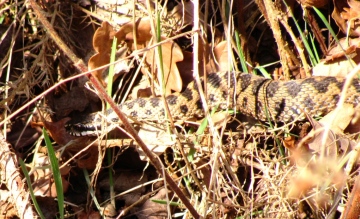
Spring truly has begun to spring! Update on the day
After posting the below item regarding ladybirds in the garden, we went for a walk round the perimeter of Mistley Place Park. Ladybirds we had been observing all winter in wooden fence posts etc have moved out of their winter quarters and were taking in the sun.
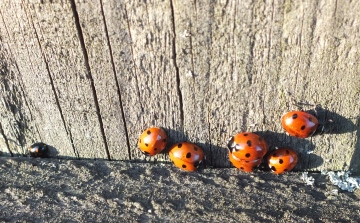
At The Walls one particular tree had many Pine ladybirds, 49 actually counted up to a height of about 12ft from the root many were mating.
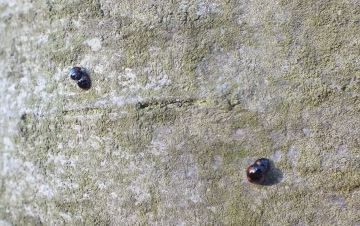 What a difference a day makes
This morning started sunny and the temperature rose very quickly in the garden. Insects appeared everywhere the most numerous being 7-Spot Ladybirds with 90 actually counted, one pair mating, and with many places where I couldn't get to, the number was probably much higher. With them were two Pine Ladybirds two species of hoverfly, Honey Bees, a Common Carder, Drone Fly, Bluebottles, a Rosemary Beetle and numerous small unidentified flies. February 12th-18th 2012
A thaw set in early in the week but the milder temperatures were offset by a lack of sunshine and stronger winds. My small garden pond was still frozen solid on 14th but free of ice three days later when I disturbed a couple of Frogs that had survived their two week long entombment. Around 7-8 years ago I counted nineteen dead frogs in the pond during the early spring, all of which appeared to have died from the so-called Red-leg Disease; since when they have never really re-established themselves and I only occasionally find spawn. When it does occur very few young frogs survive the tadpole stage, being gobbled up by a large population of Smooth Newts (a maximum of 22 of which were counted in 2011), and a few of these were also active this week.
A visitor to Blue House Farm EWT Reserve reported finding seventeen dead waders along the shore this week - mostly Dunlin but also a few Knot and single Grey Plover and Curlew. He suggested that they might have been shot and although this could have been the case (although not on the reserve!) I think a more likely scenario is that they died as a result of the severe weather. Even towards the close of a relatively mild winter like this one has been many birds will - for a variety of reasons - be at a low ebb and the icy conditions we experienced last week, when night-time temperatures fell as low as -12'C on a couple of occasions, could easily spell the difference between survival and death. They are unlikely to have all died together but were probably washed into the large bay (known locally as a 'horseshoe') by the prevailing tidal currents. Mass deaths like this were of fairly frequent occurrence during the harsh winters of the 1960s and 1970s. Another result of the cold weather has been an influx of Woodcock into gardens (including my own), they having been frozen out of their usual woodland haunts, while I have even heard reports of the odd Lapwing visiting residential areas, a sure indication in both instances of birds facing starvation.
On a happier note, no sooner did the temperature rise this week than Blackbirds and Chaffinches joined the dawn chorus in the garden and both Reed Bunting and Yellowhammer that in the countryside. When it comes to the latter I can still hear the "little bit of bread and no" but not the high pitched "cheese" at the end of it! The garden moth trap, set set for the first time this month, on 17th, yielded two species -
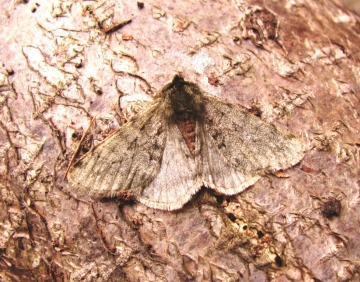
a Chestnut and a Pale Brindled Beauty (pictured) while during a work party at Poors Piece EWT Reserve on 18th one of the volunteers disturbed a queen Hornet and another found a Glow-worm larva. This may possibly be a new site for this species. Finally, after a temporary close down due to the snow, the fungi 'season'resumed when I found several specimens of the Dung Roundhead Stropharia semiglobata on a well rotted cow pat at Blue House on 16th. Frogs continued
Things have got a little better. There were 4 frogs in the pond later in the day (Friday), including a mating pair. The following morning there was a nice clump of spawn in the pond and later still I counted about 24 frogs. However nearly all were males. On reflection I think nearly all of the dead have been females. I pulled another two dead frogs out of the pond, one with an amorous male attached to it still. The pond is very silty and so its difficult to see everything in it. On Sunday I pulled another ill-matched couple out. As its gone colder numbers have fallen. This morning there was some ice back on the pond, though at least one frog was present. They must be having a pretty tough time of it though.
Dave Frog survivors
We were interest to see your comment David.
We have a very tiny pond in our garden, about 2' x 3' x 1'6", before the cold snap the frogs had appeared and as the pond froze over with thick ice we feared for their safety.
However tonight, to our surprise, we have two very fat females and three males in residence. The worst is over?
I hope so. I just pulled 7 dead frogs out of my garden pond in Leyton. I hadn't expected them so soon after the freeze. Maybe I'd allowed the pond to become too choked and therefore shallow.
Dave Spring has sprung ?
The many hundreds of 7-Spot Ladybirds hibernating along New Rd, Mistley had been semi active until the snow and frosts drove them deep into the fence post crevices and shrubs. Today in the sunshine they have suddenly become very mobile, wandering about the fences and hedgerows. Do they know the worst has passed ? We even saw a Magpie carrying nest material in the garden. Ever hopeful. February 5th - 11th 2012
Five inches of snow fell during the early hours of 5th and barely thawed at all during the following week in rural areas. Despite that the first spring lamb appeared this week at Blue House and seems to be coping well despite temperatures falling as low as -10`C some nights. He was earlier than anticipated due to the fact that his father developed an unexpected talent for showjumping last autumn!
Most wildlife is hunkered down for the duration of the cold spell but a visit to Fryerning Churchyard on 5th produced evidence of a good deal of mammal activity the previous night as the snow was crisscrossed with the tracks of Fox, Rabbit, Brown Hare, Fallow and Muntjac Deer, Brown Rat, Grey Squirrel, Stoat or Weasel, and Badger. Unprecedented numbers of Redwing have also been visiting my garden, peaking at 62 on 11th, and they have been stripping everything in the vicinity with a berry attached to it!
On 7th I 'twitched' 6 Goosander on the River Chelmer at Chelmsford, close to the ERO, a regular site during severe weather when they are forced to flee their usual haunts - gravel pits at Great Waltham.
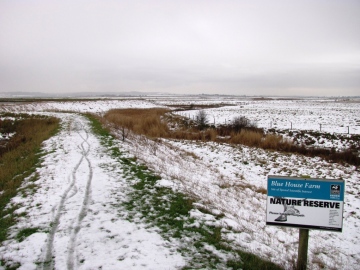
Blue House was bleak to the eye during a visit on 9th and there were few birds on the frozen fleets. At least 200 Skylarks, though, were grubbing a subsistence living in the few patches of bare ground on the seawall and saltings, and there was a Great Northern Diver fishing for crabs in the River Crouch. He had a macabre way of dealing with the larger crabs, revolving the unfortunate gastropod in its bill and neatly nipping off each of its legs in turn until - rendered legless in the most literal sense - it was dispatched stomach-wards with a quick toss of the head! January 29th-February 4th 2012
Winter returneth. A cold, grey, but mostly dry week with often severe overnight frosts although the ear nipping, nose numbing north-easterlies at the beginning mercifully slackened off by the its close. Everything feels dormant; only the birds bring life and colour to a landscape. But they too are in cold weather mode, doing everything they can to conserve energy. Scan the sky and there are few birds flying apart from Wood Pigeons commuting between oilseed rape fields; even the normally acrobatic flocks of Rooks and Jackdaws, which delight in tumbling on the breeze, have curtailed their antics while the flocks of tits and other small birds working their way through the trees are strangely mute. At Blue House Farm, North Fambridge the Dunlin flocks have trebled in size and have been joined by groups of Knot, refugees from the exposed shores of the Dengie coast. All the waders are remarkably tame, their normal wariness inhibited by the cold, so reluctant are they to fly. If not exactly walking at your feet, like the Turnstones on Southend Pier, they feed happily (if feverishly) within a few yards of them. Even a week of very cold temperatures can numb muscles and slow reactions, a Dunlin paying the price of a few seconds delay at the talons of a marauding Sparrowhawk. Not all birds are suffering; 1100 Cormorants were seen sitting on sandbanks during a BTO Low Tide Count between Steeple Stone and Bradwell Power Station on 31st. They must get through a hell of a lot of sprats during the course of a week!
A bonfire was a welcome refuge from the cold at The Backwarden on 1st, its fuel a recently felled tree suffering from Acute Oak Decline. A white-capped, pink-gilled, stemless agaric growing on bramble stems keyed out as the Variable Oysterling Crepidotus variabilis; this and its relative C.cesatii (which has no English name), found on gorse stems at Mill Green Common on 29th, kept the fungi season going for another week. There were few signs of insect life though apart from a Chestnut (illustrated) which turned up in the kitchen one evening.
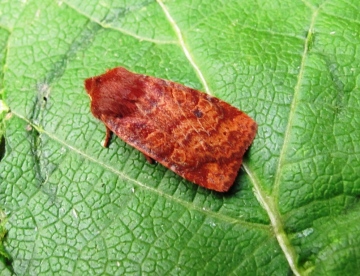
Rob Smith, County Butterfly Recorder, did find a single egg of a Purple Hairstreak on the bud of a scrub oak at Mill Green, one that was due to be removed. It has now been spared and we wait with interest to see if the egg survives the frosts and foraging tit flocks to hatch in the spring.
Thanks Mike. It is a shame that more people (including members!) do not use this forum to record their latest finds or to post queries and discuss ideas, especially after all Peter's hard work to put the website in place. Perhaps part of the problem is that in the modern age every special interest group, whether it be birds, moths, dragonflies or whatever, all have their own websites, many of whose members have little interest in other natural history disciplines. I would not necessarily knock this as they often do great work but do not see why it should preclude them from being aligned to an umbrella group such as the Field Club and to contribute to a forum such as this. The trouble from my point of view is that if your interests are more wide ranging you need to access each of them in order to find out the latest news. My own interest in natural history started in toddler-hood and over the years I have become reasonably knowledgeable in a number of subjects. Others I know little about but am always interested in learning more. One such is geology, a subject on which I am a little better informed than previously thanks to articles by Peter Allen and Gerald Lucy in the Essex Naturalist, a journal I always read from cover to cover, even articles on the statistical analysis of weather dependence in Stag Beetles in NE Essex. Maths and statistics were always of profound mystery to me! The Forum and more rock deliberations.
First, enjoyed your Writtle account Graham, a good read and since the Club covers
much of this sizeable County, for many of us, there being no local group in our region
to bring us regularly together, maybe we should increasingly use this Forum as a sort of
'meeting place' to air our views, images and to promote discussion. Long ago I used to
attend the EFC meetings in the College lecture theatre at Stratford. The days of relativ-
ely cheap fuel for the car and reasonable bus and train fares if you preferred to use
public transport to get to the monthly meetings and visit the Passmore Edwards Museum,
but those times now far off and so journering all across Essex, to Romford, Basildon -
Watt Tyler Centre a bit of a stretch, sure costly as well, for us living up in this north-
east corner of the County. So having found this Forum, nice to hear what people have
to say and maybe I can contribute my thoughts if I think some topic might be of interest
to others.
So just a further note concerning the Harwich Stone Band. I know this rock layer fairly
well, but do not think it offers much in the way of habitat for fish, broken off pieces will
provide a refuge for crabs and pools in the uneven and fractured layer are a place for
small fry to hide whilst they await the tidal waters to once more envelope the shore.
The granite armour rock that has been placed along much of the coast here, does of
course create many voids in which fish can take refuge, search for food and deposit
spawn, likewise similarly for the invertebrate community. Encouraged my Peter's remarks,
it may be a useful project to contact those who run local angling shops to encourage
them to let me know of any unusual catches. I even thought of dropping a baited hook
(barb ground off) myself, close to the rocks to see if there are any takers. The anglers
seem always intent on casting their baits as far out as possible and this may preclude
any chance of securing some rock loving species. So Peter I may eventually have some
further news for your Forum |
|
Archives:
May 2020
Aug 2019
Jan 2019
Sep 2018
Jul 2016
Oct 2015
Jul 2015
May 2015
Apr 2015
Mar 2015
Feb 2015
Jan 2015
Dec 2014
Oct 2014
Sep 2014
Aug 2014
Jul 2014
May 2014
Apr 2014
Mar 2014
Feb 2014
Jan 2014
Dec 2013
Nov 2013
Sep 2013
Aug 2013
Jul 2013
Jun 2013
May 2013
Apr 2013
Mar 2013
Feb 2013
Jan 2013
Dec 2012
Nov 2012
Oct 2012
Sep 2012
Aug 2012
Jul 2012
Jun 2012
May 2012
Apr 2012
Mar 2012
Feb 2012
Jan 2012
Dec 2011
Nov 2011
Oct 2011
Sep 2011
Aug 2011
Jul 2011
Jun 2011
May 2011
Apr 2011
Mar 2011
Feb 2011
Jan 2011
Dec 2010
Nov 2010
Oct 2010
Sep 2010
Aug 2010
Jul 2010
Jun 2010
May 2010
Apr 2010
Mar 2010
Feb 2010
Nov 2009
Oct 2009
Aug 2009
Jul 2009
Jun 2009
May 2009
Apr 2009
Mar 2009
Feb 2009
Jan 2009
Nov 2008
Oct 2008
Sep 2008
Aug 2008
Jul 2008
Jun 2008
May 2008
Apr 2008
Mar 2008
Feb 2008
Jan 2008
Dec 2007
Nov 2007
current posts
|























